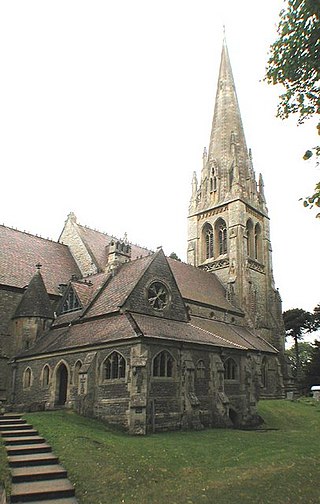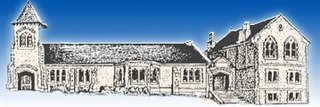
Eaton Hall is the country house of the Duke of Westminster. It is 1 mile (2 km) south of the village of Eccleston, in Cheshire, England. The house is surrounded by its own formal gardens, parkland, farmland and woodland. The estate covers about 10,872 acres (4,400 ha).

King's Sutton is a village and civil parish in West Northamptonshire, Northamptonshire, England in the valley of the River Cherwell. The village is about 4.1 miles (6.6 km) south-east of Banbury, Oxfordshire.

Gedney Hill is a village and civil parish in South Holland district of Lincolnshire, England. The population of the civil parish at the 2011 census was 737. It is situated close to the border of Cambridgeshire, and approximately 9 miles (14 km) south-east of Spalding, 8 miles (13 km) west of Wisbech and 9 miles (14 km) south of Holbeach.

Smithdon High School is a small comprehensive school academy, with 627 students in Hunstanton, Norfolk. Its buildings are Grade II* listed. It changed its status, joining the West Norfolk Academies Trust in 2016. Ofsted rated the school as 'requires improvement' in 2019.

Chilwell School is a secondary school located in Chilwell, near Nottingham, England. The school is located adjacent to the Chilwell Olympia sports complex and has an attached sixth-form college. In January 2005, the school was designated a specialist school in Arts and Maths and Computing.

Saltford is a large English village and civil parish in the Bath and North East Somerset unitary authority, Somerset. It lies between the cities of Bristol and Bath, and adjoins Keynsham on the same route. Saltford Manor House claims to be the oldest continuously occupied dwelling in England.

Henry Woodyer (1816–1896) was an English architect, a pupil of William Butterfield and a disciple of A. W. N. Pugin and the Ecclesiologists.

Marsh Baldon is a village and civil parish about 5 miles (8 km) southeast of Oxford in Oxfordshire. Since 2012 it has been part of the Baldons joint parish council area, sharing a parish council with the adjacent civil parish of Toot Baldon. The 2011 Census population is 310.

Hailey is a village and civil parish about 2 miles (3 km) north of Witney, Oxfordshire. The village comprises three neighbourhoods: Middletown on the main road between Witney and Charlbury, Poffley End on the minor road to Ramsden and Delly End on Whiting's Lane. The parish extends from the River Windrush in the south, almost to the village of Ramsden and the hamlet of Wilcote in the north, and it includes the hamlet of New Yatt. The 2011 Census recorded the parish's population as 1,208.
Buglawton Hall is a former country house, later a school, to the northeast of Buglawton, a suburb of Congleton, Cheshire, England.

Fitzjohn's Primary School is a community primary school in Hampstead, London. The school was established in 1953. The school took over the school buildings and some of the grounds that were previously part of the estate belonging to the Royal Soldiers' Daughters' Home. There is also a nursery school which opened in 2006. The school is authorised to have a maximum of 230 pupils, including the nursery intake.

St Mary's Church is in St Mary's Street, Preston, Lancashire, England. It is a redundant Anglican parish church, and was converted into a conservation centre in 2006. The church is recorded in the National Heritage List for England as a designated Grade II listed building.
George H. Widdows was an English architect who pioneered changes to school building design to enhance the health of school children. He was also responsible for the design of about 80 schools in Derbyshire, where he became Chief Architect.
Medlar-with-Wesham is a civil parish in the Borough of Fylde, Lancashire, England. It contains three buildings that are recorded in the National Heritage List for England as designated listed buildings, all of which are listed at Grade II. This grade is the lowest of the three gradings given to listed buildings and is applied to "buildings of national importance and special interest". The parish contains the town of Wesham, and is otherwise rural. The listed buildings consist of a farmhouse, a church, and a war memorial.
Mellor is a civil parish in Ribble Valley, Lancashire, England. It contains ten listed buildings that are recorded in the National Heritage List for England. Of these, one is at Grade II*, the middle grade, and the others are at Grade II, the lowest grade. The parish contains the village of Mellor, and is otherwise rural. The only listed building in the village is the church. The other listed buildings are houses and associated structures, farmhouses, and a bridge.
Manchester is a city in Northwest England. The M16 postcode area is to the south of the city centre, and contains the area of Whalley Range. The postcode area contains 13 listed buildings that are recorded in the National Heritage List for England. Of these, one is listed at Grade II*, the middle grade of the three grades, and the others are at Grade II, the lowest grade.
Scarcroft is a civil parish in the metropolitan borough of the City of Leeds, West Yorkshire, England. The parish contains eight listed buildings that are recorded in the National Heritage List for England. All the listed buildings are designated at Grade II, the lowest of the three grades, which is applied to "buildings of national importance and special interest". The parish contains the village of Scarcroft and the surrounding countryside, and the listed buildings consist of houses, a former toll house, and three milestones.
Brierley is a town and Grimethorpe is a village in the North East Ward in the metropolitan borough of Barnsley, South Yorkshire, England. The ward contains six listed buildings that are recorded in the National Heritage List for England. Of these, one is listed at Grade II*, the middle of the three grades, and the others are at Grade II, the lowest grade. The listed buildings consist of three houses, a farmhouse, a milepost, and a church.
Clifton and Compton is a civil parish in the Derbyshire Dales district of Derbyshire, England. The parish contains eight listed buildings that are recorded in the National Heritage List for England. Of these, one is listed at Grade II*, the middle of the three grades, and the others are at Grade II, the lowest grade. The parish contains the villages of Clifton and Hangingbridge, and the surrounding area. The listed buildings consist of houses, cottages and associated structures, a church, its lychgate and wall, a road bridge, and a public house.
Awsworth is a civil parish in the Borough of Broxtowe, Nottinghamshire, England. The parish contains four listed buildings that are recorded in the National Heritage List for England. Of these, one is listed at Grade II*, the middle of the three grades, and the others are at Grade II, the lowest grade. The parish contains the village of Awsworth and the surrounding area, and the listed buildings consist of a railway viaduct, a school and associated structures, and a war memorial.














